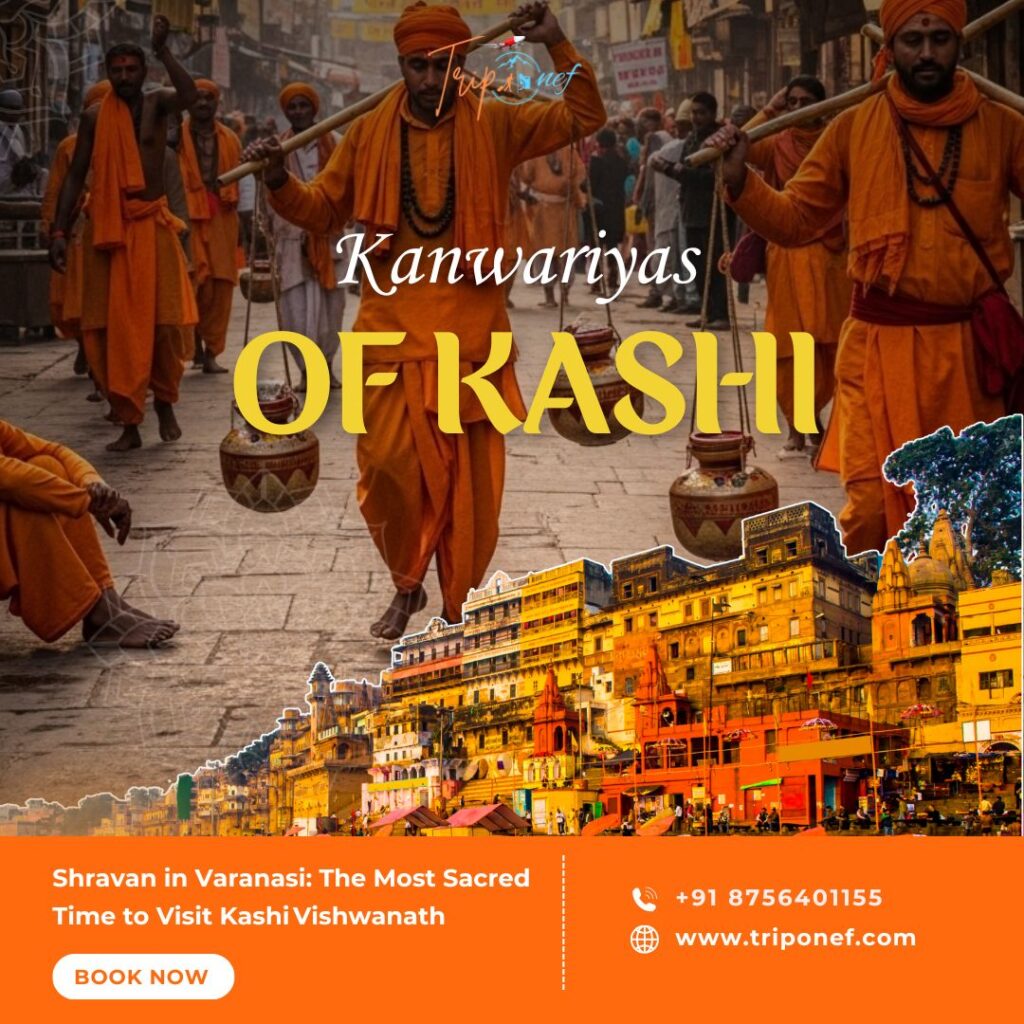
Kanwariya Stories Varanasi: A Pilgrimage of Fire, Faith, and Barefoot Devotion
Every Shravan, Varanasi becomes a spiritual epicentre for thousands of saffron-clad devotees walking the sacred Kanwar Yatra. These aren’t just pilgrims—they are walking legends. The Kanwariya stories Varanasi witnesses each year are deeply moving, packed with devotion, pain, and personal vows that turn faith into action.
Every July, the spiritual air of Varanasi begins to pulse with something extraordinary. The ghats echo with chants of “Bol Bam!”, streets glow saffron with flowing crowds, and bamboo poles sway with pots of Ganga-jal. These are the Kanwariyas — barefoot devotees of Lord Shiva — and this is not just their walk. It’s their mission, their penance, and their story.
For outsiders, it may look like chaos. But for those who walk it, it’s a sacred calling. And for those who witness it, it’s unforgettable.
Inspiring Kanwariya Stories from the Streets of Varanasi
The Kanwar Yatra is the world’s largest annual foot pilgrimage. Millions of Kanwariyas collect water from the Ganga — often from Haridwar, Gaumukh, or Sultanganj — and carry it across states to offer it at the nearest Shiva temple.
For many from Bihar, Jharkhand, and eastern Uttar Pradesh, their destination is none other than Kashi Vishwanath — one of the twelve Jyotirlingas of India.
This year, in 2025, Shravan begins on July 11 and ends on August 9. Authorities expect over 30 million participants across India, with Varanasi being a major convergence point. The crescendo of this spiritual march builds toward Shravan Shivratri on July 23 — when the city is at its most vibrant, chaotic, and divine.
Stories That Make the Yatra What It Truly Is
One of the most emotional Kanwariya stories Varanasi locals love to share is about a young boy from Bihar who walked 300 km barefoot to Kashi Vishwanath after his father recovered from a critical illness. His journey is a symbol of hope, faith, and promise kept.If you ask any Kanwariya why they walk, you won’t get statistics. You’ll get stories.
One of the most well-known Kanwariya stories in Varanasi comes from 1932 — the year of a terrible drought. Five Yadav farmers made a vow: if Lord Shiva brought back the rains, they’d walk every year to Kashi with Ganga-jal. The rains came. Their crops grew. And so began a generational tradition. Today, over 50,000 people from their village continue that promise, walking hundreds of kilometers every year.
Others walk in silence — in memory of lost parents or to fulfill vows made in the darkest days of illness. One young man we met near Dashashwamedh Ghat whispered, “My mother was in the ICU. I told Bholenath if she wakes up, I’ll walk barefoot to him. She did. So here I am.”
In every rest camp, every langar, and every roadside sleep-stop, there’s another story. Some are dramatic. Some are deeply personal. But all of them form the emotional heartbeat of this sacred journey.
What the Journey Looks Like (and Feels Like)
Carrying water on your shoulders, walking 25 to 30 kilometers a day, and braving intense heat with no shoes isn’t something most people train for — but Kanwariyas aren’t most people.
The bamboo pole they carry is called a “kanwar”, balanced on the shoulders with pots hanging on either side. It’s sacred, and touching it accidentally is considered disrespectful.
Along the route, you’ll find:
Devotional DJs: Mini speakers playing Bhojpuri Bol Bam songs
Reflective safety strips on clothes and pots to prevent road accidents
Energy drinks, ORS sachets, and balms being shared like holy offerings
And yet, no matter how tough it gets, most walk with smiles, dance breaks, and even chants that echo through the night.
Why Varanasi Matters So Much to the Kanwariyas
Kashi is not just another city. It is Shiva’s own land — and for the Kanwariya, there is no greater honour than offering the holy Ganga water at Kashi Vishwanath Mandir.
The final stretch — usually from Assi to Godowlia — feels electric. Loudspeakers sing out devotional verses. Shops hand out cold water. And police teams manage the crowds with military precision and spiritual patience.
At the temple gates, some pilgrims cry. Some collapse. Others offer water with shaking hands and silent prayers.
This moment — raw, sweaty, painful, and divine — is the spiritual peak of the journey.
If You’re a Traveller or Photographer, Here’s What to Know
The Kanwar Yatra is not just for the pilgrims — it’s a cultural experience for everyone.
If you’re in Varanasi during Shravan, here are some tips:
Night is the most active time: Processions often peak between 9 PM and 4 AM.
Godowlia, Lahurabir, and Dashashwamedh Road are key routes.
Always ask before clicking photos. Some people walk with personal grief; others may be shy.
Don’t block the path — when someone shouts “Bol Bam! Side Please!” — step back quickly.
If you want to give something, offer ORS sachets, pain balms, or water — they’re far more useful than money.
For a respectful, immersive trip, you can also explore our Varanasi Travel Guide, which helps you blend pilgrimage, food, and culture into one unforgettable experience.
Eco-Friendly Moves and the Future of the Yatra
With millions walking and resting, there’s bound to be an environmental impact. But Varanasi is making progress.
Authorities are now encouraging the use of copper or steel water pots instead of plastic. Volunteer groups near Assi Ghat are even trading reusable bottles for single-use plastic containers. And for the first time in 2025, the city will be monitoring plastic waste via drone-assisted tracking.
If sustainable travel matters to you, check out our post on Responsible Tourism in India for practical tips on reducing your footprint during sacred journeys.
Women Kanwariyas Are Rising Too
Traditionally, Kanwar Yatra was male-dominated. But today, more and more women are taking to the roads — either in family groups or organized circles.
In Varanasi, special rest zones for women Kanwariyas have been set up this year. Local volunteers also provide support for women walking solo. This is more than just a shift in tradition — it’s a celebration of inclusion in spirituality.
Your Invitation to Witness, Walk, or Simply Wonder
You don’t need to be barefoot to be moved. Just being in Varanasi during Shravan is enough to feel something shift within. Maybe it’s the energy. Maybe it’s the music. Maybe it’s the silent strength of a stranger walking past you with a tired smile.
The Kanwariya stories Varanasi tells aren’t written in books. They’re walked, sung, cried, and poured out with every drop of Ganga-jal.
So whether you want to walk a kilometre or watch from the ghat steps, make space in your July calendar. Because this isn’t just a festival—it’s faith on foot.
Whether you join the walk or simply stand aside in awe, the Kanwariya stories Varanasi offers during Shravan will leave a mark on your soul. These stories of barefoot faith, fierce determination, and divine love remind us why Kashi remains the beating heart of devotion in India.
If you’d like to explore the other spiritual and cultural dimensions of Banaras, check out our blog Banarasi Thali to Paan: A Foodie’s Journey Through Varanasi or book a heritage walk through our Triponef Experiences page.
And if you do attend the Kanwar Yatra this year, don’t forget to tag us on Instagram using #TriponefWalks — we’d love to feature your journey.

